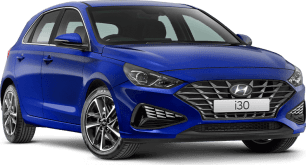Honestly, the changes described in the press material had me hoping for a pretty different drive experience to the i30 N hatch... but without a back-to-back drive, most people would be hard pressed to pick up on the differences. I'll admit it - I struggled, and Hyundai didn't give us the chance to sample the regular model against this one.
According to Hyundai, the Fastback N model rolls on a "new global chassis calibration" that was honed on the Nurburgring to reward the driver with "controlled and comfortable" handling - the very same tune that will be rolled out on the hatch sometime in 2019, according to the brand.
That tune incorporates a softer front suspension with reduced roll stiffness, which apparently makes it more comfortable but also more chuckable in corners. I thought the i30 N hatch was already pretty good at that, but oh well.
There are longer, softer bump-stops, as well as a new, narrower front anti-rollbar, plus the adaptive dampers are revised as well.
As for drive modes, you can choose from Eco, Normal and Sport drive modes, as well as N mode with an ESC Sport setting, and a configurable N Custom mode (my fave: Normal steering, Normal suspension, everything else in Sport+).
But I found that the Normal mode was still a bit too firm in a lot of situations, with the rear rebound after a bump making for a pretty bouncy ride over rough back roads, and sharp edges around town still upset progress to a reasonable degree. Put the suspension in its hardest mode and the ride is even more punishing, but that's to be expected. The steering weight is a bit too stiff, and though the rack is only two turns lock to lock, the turning circle is pretty large at 11.6m.
The i30 Fastback N is marginally heavier (12kg) mainly at the rear, which affects the weight distribution - the company says the ratio is 59.7 per cent front and 40.3 per cent rear, where the hatch is 61.8/38.2. That probably won't matter to the vast majority of owners and customers, but it theoretically helps with the more tail-happy character of the Fastback.
Unleashing the grunt of the engine and throwing the shifter between the gates, allowing it to do the throttle-blipping for you on downshifts - it takes a while for it to get old. But like most other front-wheel drive hot hatches, you can induce understeer if you approach a bend with too much heat, and there's also a bit of a battle to be had with the steering wheel under hard acceleration, with some torque-steer tug noticeable.
On the road you will still find yourself smiling stupidly when you lift off the throttle and hear the pop and fart of the exhaust system... provided you can hear it. If the surface is coarse - like a lot of highways and main roads in Australia - you might struggle, because there's a lot of road noise intrusion into the cabin. Some extra sound deadening wouldn't go astray.
Many of my criticisms are more around the perception of the new body type than the actual drive experience, which is still great for a high-powered hatch... fastback... coupe... whatever.
But with Hyundai's own marketing people telling us that this is a softer and more grown-up offering, I expected its character to match its more mature appearance a bit more than it did.

